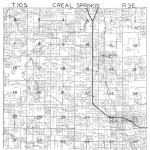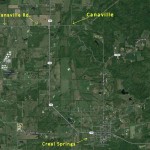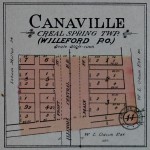Canaville post office was opened May 31, 1888 with William H. Willeford as postmaster. The railroad was being built from Marion to Creal Springs and on south. Mr. Willeford had been postmaster at Creal Springs for a few months in 1884 and secured the new post office as part of a plan to develop a new town.
 Railroad service was begun January 1, 1889 and a station built at Canaville. A town site was surveyed in section 11 of Creal Springs Township, and this village plat filed in the courthouse December 26, 1889.
Railroad service was begun January 1, 1889 and a station built at Canaville. A town site was surveyed in section 11 of Creal Springs Township, and this village plat filed in the courthouse December 26, 1889.
But the projected village never materialized. Postmaster Willeford built a house in which he lived and ran a grocery store. During the railroad construction he had a contract for buying railroad ties from the saw mills in the neighborhood, and later this business changed to handling mine timbers. The farmers’ grange built a two story brick hall across the tracks, and after they disbanded Mr. Willeford used their building. The upper floor was his home; the lower, the post office and grocery.
The Illinois Central bought the railroad in 1904 and found the station name conflicted with another
on their line in Kentucky. The name Willeford was given Canaville, in honor of the first postmaster, and the post office was changed to conform on February 12, 1906. William H. Willeford (1855-1897) was the grandson and namesake of the first printer and newspaper publisher in Williamson County.
 The original name of Canaville was given in honor of Cana Missionary Baptist Church half a mile west of the railroad station. His church stands just north of where Cana and Little Cana creeks join in the eastern part of Creal Springs Township. There were canebrakes along those creeks, and their original name was Caney. The church people changed the name to recall the first miracle, changing the water into wine, at the marriage feast of Cana of Galilee.
The original name of Canaville was given in honor of Cana Missionary Baptist Church half a mile west of the railroad station. His church stands just north of where Cana and Little Cana creeks join in the eastern part of Creal Springs Township. There were canebrakes along those creeks, and their original name was Caney. The church people changed the name to recall the first miracle, changing the water into wine, at the marriage feast of Cana of Galilee.
Among the residents of the neighborhood in the days before railroad and post office were thought of was B. D. Caplinger the blacksmith. He came from his father’s home near Caplinger’s pond to practice the family trade, enlisted in the Union army, and died a prisoner at Andersonville. The Grand Army of the Republic post at Creal Springs was named in his honor.
(Extracted from Pioneer Folks and Places, Barbara Barr Hubbs, 1939, on sale at the Williamson County Museum)

